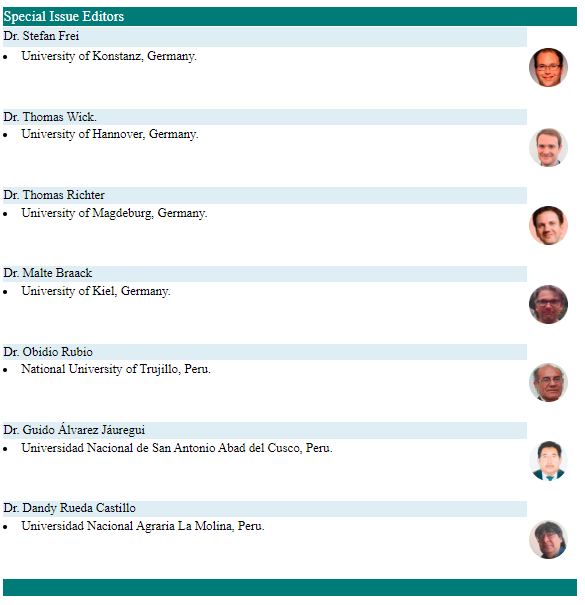Mathematical model for the study of the diffusion of Zika. Computational experimentation in Paramaribo and Santa Ana
DOI:
https://doi.org/10.17268/sel.mat.2019.02.06Palavras-chave:
Diffusion, epidemic, model, ZikaResumo
Zika virus spreads to people primarily through the bite of an infected Aedes aegypti species mosquito. But it Zika can also be passed through sex from an infected to his or her sex partners and it can be spread from a pregnant woman to her fetus. Zika continues to spreading geographically to areas where competent vectors are present. Although a decline in cases of Zika virus infection has been reported in some countries, or in some parts of countries, vigilance needs to remain high. In this work, we propose a mathematical model that uses diffusion-advection equations to study the impact of the Zika epidemic. We present a numerical scheme linking finite elements (FEM) with finite differences to solve the model. The computer simulations are performed for Paramaribo and Santa Ana that have different demographic characteristics and allow us to extend the study to other regions.Referências
Butcher, J. C. Numerical method for ordinary differential equations, JohnWiley and Sons, 2003. doi: 10.1002/9780470753767.
Ciarlet, P. G. The finite element method for elliptic problem, SIAM, 2002. ISBN: 978-0898715149.
Crank, J. and Nicolson, E. A practical method for numerical evaluation of partial differential equations of the heat conduction type, Proc. Camb. Phil. Soc., 1947; 43(1):50-67. doi:10.1017/S0305004100023197.
Dick, G. W. A., Kitchen, S. F. and Haddow, A. J. Zika Virus. I. Isolations and serogical specifity, Trans R Soc Trop Med Hyg, 1952; 46(5):509-520. doi:10.1016/0035-9203(52)90042-4.
Dick, G. W. A., Kitchen, S. F. and Haddow, A. J. Zika virus (II). Pathogenicity and physical properties, Trans R Soc Trop Med Hyg, 1952; 46:521-534. doi:10.1016/0035-9203(52)90043-6.
Bonyah Ebenezer and Okosun Kazeem. Mathematical Modelling of Zika virus. Asian Pacific Journal of Tropical Disease. doi:10.1016/S2222-1808(16)61108-8
Delgado, E. M. and Marrero S. A. Mathematical models for Zika with exposed variables and delay. Comparison and experimentation in Suriname and El Salvador, Selecciones Matemáticas, ISSN: 2411-1783, 2019. doi:10.17268/sel.mat.2019.01.01.
Kassen, T. G. and Garba, E. J. D. A mathematical model for the spatial spread oh HIV in heterogeneous population, Mathematical Theory and Modeling, 2016; 6(4):95-104. ISSN: 2224-5804.
Lin, H. and Wang, F. On a reaction-diffusion system modeling the Dengue transmission with nonlocal infections and crowding effects, Applied Mathematics and Computation, 2014; 248:184-194. doi: 10.1016/j.amc.2014.09.101.
Lotfi, E. M., Maziane, M., Hattaf, K. and Yousti, N. Partial differential equations of an epidemic model with spatial difussion, International Journal of Partial Differential Equations, volume 2014, article ID 186437, 2014. doi: 10.1155/2014/186437
Macufa, M. M., Mayer, J. F. and Krindges, A. Difussion of Malaria in Mozambique. Modeling with computational simulations, Biomatemática, 2015; 25:161-184.
Maidana, N. A. and Yang, H. M. A spatial model to describe the Dengue propagation, TEMA, Tend. Mat. Apli. Comp., 2007; 8(1):83-92. ISSN: 1677-1966.
Prevention of sexual transmission of Zika virus: interim guidance update, Geneva: World Health Organization; 2016 (WHO/ZIKV/MOC/16.1 Rev.3; https://apps.who.int/iris/handle/10665/204421)
Peng, R. and Zhao, X. Q. A reaction-diffusion SIS epidemic model in a time periodic environment, Nonlinearity, 2012; 25:1451-1471. DOI: 10.1088/0951-7715/25/5/1451.
X. Ren, Tian, Y., Liu, L. and Liu, X. A reaction difussion withen-host HIV model with cell-to-cell transmision, J. Math. Biol., 2018; 76:1831-1872. DOI: 10.1007/s00285-017-1202-x.
Shutt, D. P., Manore, C. A., Pankavich, S., Porter, A. T. and del Valle, S. Y. Estimating the reproductive number, total outbreak size, and reporting rates for ZIKA epidemics in South and Central America, Epidemics, 2017; 21:63-79. DOI:10.1016/j.epidem.2017.06.005.
Tiemi, T. T., Maidan, N. A., Ferreira Jr, W. C., Paulino, P. and Yang, H. Mathematical Models for the Aedes aegypti dispersal dynamics: Travelling waves by wing and wind, Bulletin of Mathematical Biology, 2005; 67:509-528. DOI:10.1016/j.bulm.2004.08.005.
Downloads
Publicado
Como Citar
Edição
Seção
Licença
Os autores que publicam nesta revista aceitam as seguintes condições:
Os autores mantêm os direitos autorais e atribuem à revista o direito da primeira publicação, com o trabalho registrado com a licença de atribuição Creative Commons Atribución 4.0 Internacional (CC BY 4.0), que permite que terceiros usem o material publicado sempre que mencionarem a autoria do trabalho e os direitos autorais. Primeira publicação nesta revista.
Os autores podem fazer outros acordos contratuais independentes e adicionais para a distribuição não exclusiva da versão do artigo publicada nesta revista (por exemplo, incluí-la em um repositório institucional ou publicá-la em um livro), desde que afirme claramente que o trabalho Foi publicado nesta revista.
É permitido e recomendado aos autores que publiquem seus trabalhos na Internet (por exemplo, em páginas institucionais ou pessoais) antes e durante o processo de revisão e publicação, pois isso pode levar a trocas produtivas e a uma disseminação maior e mais rápida do trabalho. publicado (Consultar: efeito do acesso aberto).












